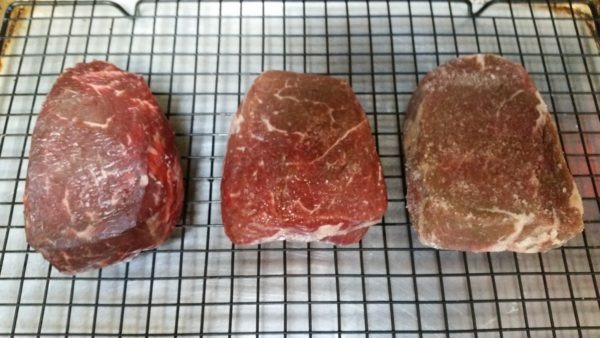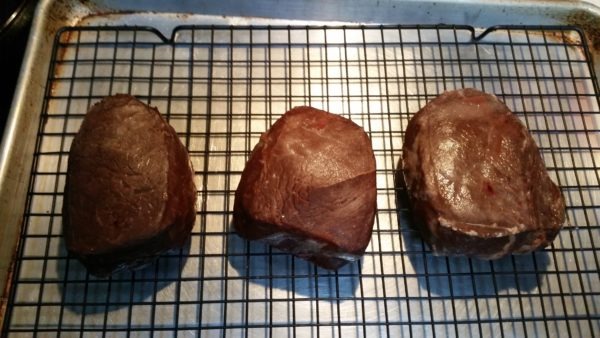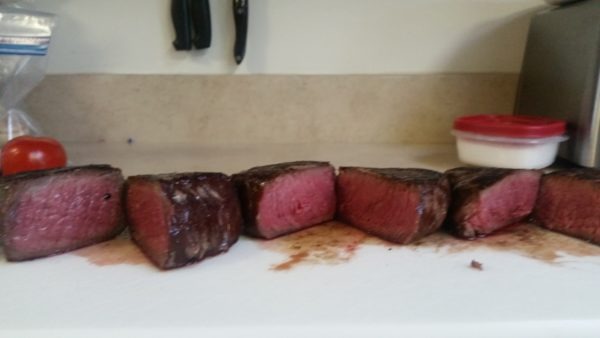How To Tell If Steak Is Bad After Cooking
This post contains affiliate links. When you buy something through them I earn money to buy more steaks but the opinions are totally my own and are 100% real.
Ahhh, steak. There are few foods on the planet that scream flavor and texture like a well cooked, well seasoned steak. But how do you go about getting the best seasoning on a steak? Now when I say "seasoning" on a steak I pretty much just mean salt and maybe a little ground pepper. I don't think a steak really needs garlic, thyme, rosemary, seasoning salt, etc. to taste delicious. Those flavors cover up too much of the good, beefy taste and salt just enhances that taste.
So if I am just going with salt I want to maximize the effect the salt has. Salt is a pretty magical rock. It can season, preserve, brine, change the texture of the meat, and so on and so forth. I wanted to test when the best time to salt a steak would be in order get the best texture and flavor. Usually I salt the steak 20-40 minutes before cooking but to change things up I wanted to try salting 24 hours before cooking and right before cooking as well to see what differences I could notice.

I got my 10 oz top sirloins from Snake River Farms a couple weeks ago when they were on sale buy one get one free. I love the quality of the steaks from Snake River Farms and would recommend them to anyone. These ended up being just $6 each which is a great price for this quality of meat. Anyway, I took the one on the far left, salted it (3-4 grams of salt), put in on a rack and stashed it in the fridge uncovered overnight. The middle one I salted 40 minutes prior to cooking and the one on the right I salted right before I cooked it.
It is a bit hard to tell in the picture but the one salted for 24 hours has a much drier exterior than the others and the outside is almost a bit leathery. The one I salted right before cooking definitely has the most surface moisture. Just to measure moisture loss I weighed each of the steaks before cooking: 270 grams, 264 grams, and 272 grams. We will find out about moisture loss in a bit.
I then put the steaks in a 225 degree oven on the rack for about 60 minutes until the internal temperature was 115 degrees. After they got to temperature I rested them for about 5 minutes and they gained another 5 degrees. 120 degrees is a great temperature for a nice medium rare steak. When the come out of the oven they aren't the most appetizing thing to look at:

At this point they are definitely edible but don't have any sort of crust on them. Again, the one salted for 24 hours has less surface moisture than the one salted right before cooking and the one salted 40 minutes is right between those.
Now it is time to put a sear and crust on these and really amp up the flavor and texture. I got my cast iron skillet (you do have a cast iron skillet don't you?) as hot as I could on the stove, put in a bit of canola oil, and put the steaks in. If you want to see the process I got it on video. Only takes about a minute per side and be sure to open your windows and doors because this is going to get smokey
As you can see from the video and the picture below the steak that was salted 24 hours before cooking got the best sear which is to be expected. You need a dry surface to sear (blog post on that coming sometime in the future) and since that steak had the least surface moisture I expected it to get the best sear. The others were more than fine though. BTW, the lines you see on the steak were from where they were resting on the grate before cooking.

And now let's cut into these bad boys and see what we have:

It is always a great feeling to cut into a steak and know that you nailed it. These were pretty much cooked perfectly for my liking. Nice, deep pink all the way through. Notice how the pink goes edge to edge. That comes from the slow cooking followed by a very hot, short sear.
All these steaks were very juicy. The one salted 24 hours lost about 40 grams from the time it was salted to the time it was done cooking. The other two lost about 30 grams. 10 grams of water really isn't much but I did notice more juice under that steak under the rack before cooking.
But more importantly, how did they taste and what was the texture like?
Flavor-wise the steak salted 24 hours before had the best overall seasoning. The salt had time to make its way all through the meat. I took a few bites of each with the exterior cut off and you could definitely taste the difference. The middle of the steak was almost as salty as the exterior. The other two were very delicious though and I thought they had a bit more beefy flavor since they weren't covered up quite as much by the salt.
As far as texture again, the one that was salted 24 hours had a noticeably different texture than the other two. The one salted 40 minutes and the one salted right before cooking were both a bit tougher (not really in a bad way) and the one salted longer was more tender, almost more like a filet mignon than a top sirloin.
Another thing I noticed was when cut more juice ran out of the two that were salted for less time. My guess is there was less salt in the meat to hold on to the moisture so it ran out. But I am not really a food scientist so don't take my word on the reasoning for that.
Which one was the winner? I would probably ever so slightly lean towards the steak salted 24 hours. If you have the time and the foresight you should give that a try sometime but if you are rushed after a long day of work and just want to get a nice dinner on the table you won't go wrong salting the meat right before cooking. There are differences in the two but the differences are very subtle and unless you eat a lot of steak you probably won't notice the difference.
Serious Eats did a similar test and their results were pretty similar to what I found. It is always nice to be able to mimic the results of people much smarter than yourself. They say anything between right away and 40 minutes results it a lot of surface moisture but at 40 minutes the juices have mostly re-absorbed into the steak.
If you start off with a high quality steak like those from Snake River Farms and cook it to the proper temperature with the proper seasoning and it is hard to turn out a bad steak.
How To Tell If Steak Is Bad After Cooking
Source: https://completecarnivore.com/when-to-salt-steak-before-cooking/
Posted by: whitmorethemeavoking.blogspot.com

0 Response to "How To Tell If Steak Is Bad After Cooking"
Post a Comment